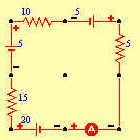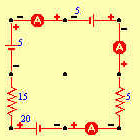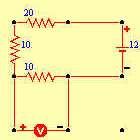
ASL
You have discovered Ohm's Law! That is wonderful. Scientists love to discover patterns like this. The next question for you, as a scientist, is: "are there more questions and discoveries hidden in the discovery I just made?" Your law shows how to equate resistance, voltage and current if you have one battery and one resistor. What happens if the circuit has 2 resistors in the loop?


ASL
Can you find a way to make Ohm's Law work for this circuit? The current and voltage are easy. You can just try putting them into the equation. What do you do with the 2 resistances? Do you add, subtract, multiply or divide them?

ASL
Build several circuits with 2 resistors and one battery in series. Put the values into the worksheet "Ohm's Law with 2 resistors in series". Replace the ? between voltage and current with the operation you discovered in the first worksheet. Replace the ? between the resistors with + - / or X to make the statement true.

ASL
In a series circuit with 2 resistors, do you add, subtract, multiply or divide the resistors?

ASL
Does the same operation work if you have 3, 4 or more resistors connected in series?

ASL
What happens if you have 2 batteries in the loop? Can you find a way to make Ohm's Law work for this circuit?


ASL
Build several circuits with 2 batteries and one resistor in series. Put the values into the worksheet "Ohm's Law with 2 batteries in series". Replace the ? between resistance and current with the operation you discovered in the first worksheet. Replace the ? between the voltages with + - / or X to make the statement true.

ASL
In a series circuit with 2 batteries, do you add, subtract, multiply or divide the voltages?

ASL
Does the same operation work if you have 3, 4 or more batteries connected in series?

ASL
Does the same operation work if you have 3, 4 or more batteries connected in series with resistors between them?


ASL
Is the current the same or different at different places in a circuit with several resistors and batteries?


ASL
From Ohm's law we can calculate that .3 amperes of current is following through the following circuit. Check the results to verify the value.


ASL
This current is flowing through all 3 resistors. Use the equation, voltage = resistance ? current with the ? replaced, to calculate the voltage across each of the resistors. Replace .3 amperes for the current and 10 ohms for the resistor. Repeat this using 20 ohms for the other resistor.

ASL
Check your calculations by inserting a voltmeter in the circuit. Check the voltage for each of the 3 resistors.


ASL
By using Ohm's Law you can calculate the current and voltage anywhere in a series circuit.

ASL
What happens if the circuit isn't a series circuit? What if there is more than one path that the electricity can flow through? The next page will help you explore this situation.

